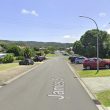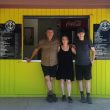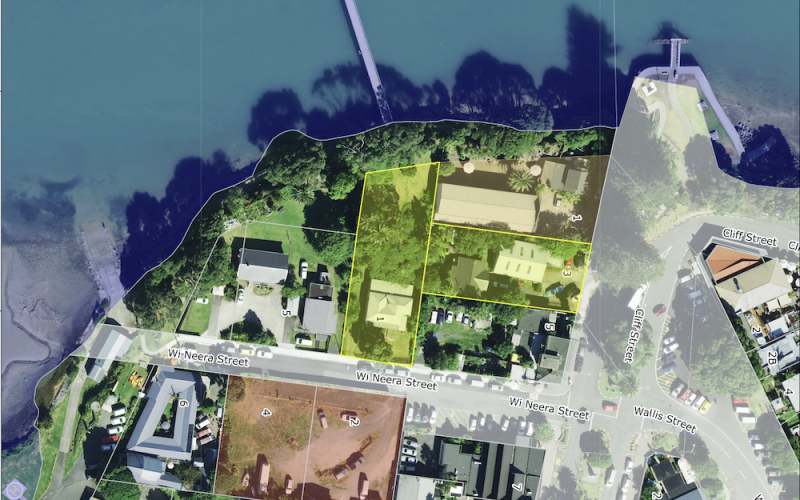On a piece of land in the heart of Raglan, just beside the police station on Wi Neera St, the past and future are converging. The site, once home to the rūnanga house of Ngāti Māhanga chief Te Awaitaia, is now the focus of an ambitious plan to reclaim its history and create a space that serves both Ngāti Māhanga and the wider community.
The Department of Internal Affairs, Lotteries Communities Facilities Fund, have confirmed the successful funding application by Raglan Naturally for a feasibility study into a possible cultural and community facility on this site and a second parcel on Bow Street, formerly Hart’s Garage. Both are rare in central Raglan, unencumbered by perpetual leases, and their availability opens the door to a project that has been talked about for decades.
The Significance of Place
For Lisa, project co-ordinator for the Toitū Whaingaroa Project Team under the Raglan Naturally Community Trust, this is about more than buildings.
“The original township name was Pūtoetoe, from the toetoe grass that was everywhere here,” she says. “Te Awaitaia was a signatory to the Treaty of Waitangi and his rūnanga house was right on this site. He welcomed everyone – settlers and Māori – under his mantle. That spirit of kotahitanga [unity] is at the heart of what we’re trying to do.”
“This is a reclamation,” Lisa says. “Reclaiming whakapapa, stories and a visible Māori presence that colonial processes tried to erase.”
Building from the Ground Up
The idea has been on Raglan Naturally’s radar for the last few years. Their community plan lists a centrally located facility as a priority, and over the past year, the Toitū Whaingaroa team (Lisa, Lara Sweetman and Michelle Levy,) alongside the Raglan Naturally hapu representatives and co chair Hans Buwalda, have worked closely with hapū representatives to develop the concept.
The process began with governance conversations. Meetings with Mayor Jacqui Church, the Deputy Mayor, councillors Tilly Turner, Eugene Patterson and Janet Gibb, as well as senior council property staff, secured in-principle support to pursue funding.
At the same time, the proposal went to Ngā Uri o Māhanga, the governance body representing the marae of Ngāti Māhanga – Aramiro Marae, Te Papa o Rotu at Whatawhata and Ōmaero Pā. Governance members referred the decision to the wider whānau, prompting a hui at Ōmaero late last year.
“There was a big turnout,” Lisa recalls. “Once we explained the opportunity to seek funding for a feasibility study and the why, whanau supported us to go to the next step and put in an application to the DIA.”
Securing the Resources to Ask the Right Questions
With hapū and council blessings, the team prepared a funding application to the Community Facilities Lottery Fund. Working entirely as volunteers, they engaged PAUA Architects of Hamilton, known for their work with hapū and on public facilities in Waikato, to manage the project.
The application succeeded, securing enough funding to undertake a full feasibility study – at no cost to ratepayers – that will determine whether the project is viable and what it could include.
“We don’t have a design yet,” Lisa says. “First we have to ask: Can we do it? What would it look like? How can it be self-funding long-term? That’s the work ahead.”
From History to Future Vision
Ideas on the table range from an arts and cultural hub to a learning and events venue, social enterprise, or a mix of commercial and community spaces to sustain the operation.
Lisa says the study will combine community workshops on Pūtoetoe’s history with design exploration and funding modelling. “We want people to understand why this site matters. We’ve already had WEL Energy Trust-funded workshops reconnecting Ngāti Māhanga whānau with the history of Pūtoetoe and Papahua, and the turnout has been huge.”
These gatherings have revealed gaps in local knowledge – even among descendants. Some believed Te Awaitaia was buried at Wi Neera St, not realising his memorial stone had been moved in 1923. “Those are powerful moments,” Lisa says. “People reconnecting with their place, their ancestors, their stories.”
A Model for Partnership
The project’s governance will be shared. A project control group is being formed, with representatives from Raglan Naturally, Ngāti Māhanga, Waikato District Council, and the wider community. This tripartite approach – hapū, community and council – is one Lisa believes could serve as a model for future projects across the district.
“We’ve started the right way,” she says. “With our Treaty partners first, then the community. It’s the respectful way to do it.”
Sky’s the Limit
When asked what the facility might look like, Lisa says, “The sky’s the limit. It could be an art gallery, a wānanga space, a social enterprise hub. It has to be self-sustaining, so maybe part commercial, part community. But it will always be about bringing people together – just as Te Awaitaia did here more than 150 years ago.”
For now, the focus is on the feasibility study, which will guide whether the project moves into design and construction. But for those involved, it already represents a kind of homecoming.
“This is resilience in action,” Lisa says. “Reclaiming history, creating a future, and making sure the stories of Pūtoetoe are seen and heard again.”
PŪTOETOE PROJECT AT A GLANCE
- Location: Wi Neera St site beside Raglan Police Station, plus former Hart’s Garage site on Bow St
- Led by: Toitū Whaingaroa Project Team under Raglan Naturally
- Partners: Ngāti Māhanga, Waikato District Council, PAUA Architects, Deloitte
- Funding: DIA Community Facilities Lottery Fund – feasibility study only, no cost to ratepayers
- Aim: Explore a self-funding cultural and community facility honouring Te Awaitaia’s legacy and serving the whole community
- Next steps: Community workshops (Saturday 13th September 930am – 12pm, venue to be confirmed), historical storytelling, design concepts, financial modelling





